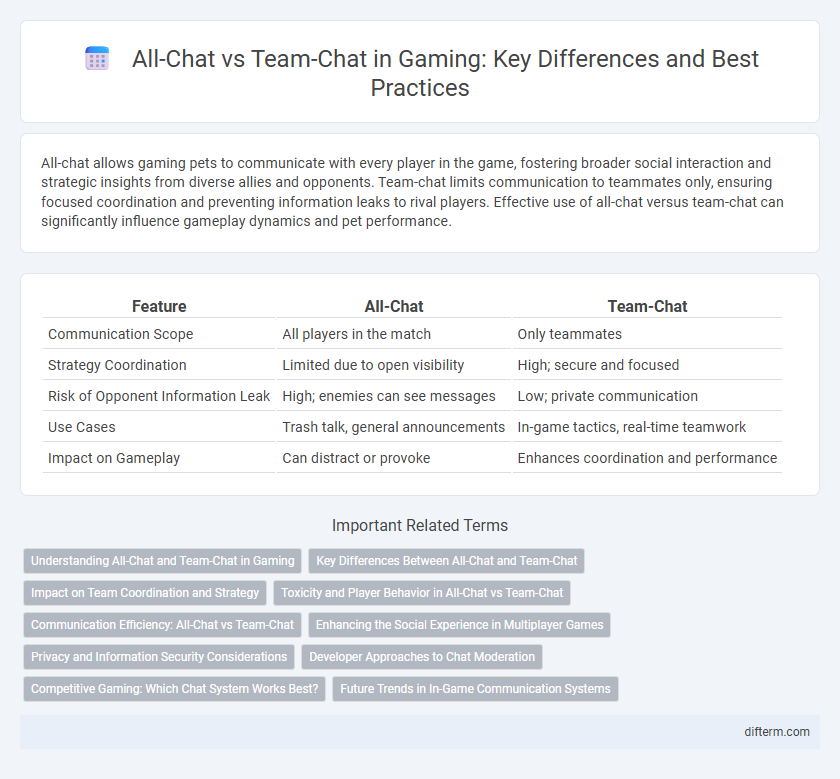All-chat allows gaming pets to communicate with every player in the game, fostering broader social interaction and strategic insights from diverse allies and opponents. Team-chat limits communication to teammates only, ensuring focused coordination and preventing information leaks to rival players. Effective use of all-chat versus team-chat can significantly influence gameplay dynamics and pet performance.
Table of Comparison
| Feature | All-Chat | Team-Chat |
|---|---|---|
| Communication Scope | All players in the match | Only teammates |
| Strategy Coordination | Limited due to open visibility | High; secure and focused |
| Risk of Opponent Information Leak | High; enemies can see messages | Low; private communication |
| Use Cases | Trash talk, general announcements | In-game tactics, real-time teamwork |
| Impact on Gameplay | Can distract or provoke | Enhances coordination and performance |
Understanding All-Chat and Team-Chat in Gaming
All-chat and team-chat are essential communication tools in multiplayer gaming that influence player strategy and interaction dynamics. All-chat enables players to communicate across opposing teams, creating opportunities for diplomacy, trolling, or gathering intelligence, while team-chat restricts communication to allies, fostering focused collaboration and tactical coordination. Mastery of when and how to use each chat mode can significantly impact a team's performance and the overall gaming experience.
Key Differences Between All-Chat and Team-Chat
All-chat allows communication with all players in a game, fostering global interaction but increasing the risk of distractions or toxic behavior. Team-chat restricts messages to teammates, promoting strategic coordination and enhancing teamwork efficiency. The key difference lies in the communication scope, with all-chat enabling broader social engagement and team-chat focusing solely on cooperative gameplay.
Impact on Team Coordination and Strategy
All-chat in gaming allows open communication between all players, which can expose strategic plans to opponents and disrupt team coordination. Team-chat enhances focused communication by restricting messages to teammates, fostering better synchronization and tactical execution. Effective use of team-chat significantly improves strategic planning and real-time decision-making, boosting overall team performance.
Toxicity and Player Behavior in All-Chat vs Team-Chat
All-chat environments often experience higher toxicity levels due to exposure to a broader audience, making it easier for negative behavior to escalate. Team-chat fosters more positive communication by limiting interactions to trusted teammates, which encourages cooperation and reduces conflicts. Understanding how chat systems influence player behavior is crucial for designing community guidelines and moderation tools that promote healthier gaming experiences.
Communication Efficiency: All-Chat vs Team-Chat
Team-chat enhances communication efficiency by restricting messages to teammates, reducing distractions and ensuring strategic coordination. All-chat exposes players to messages from all participants, which can lead to information overload and decreased focus during gameplay. Optimizing communication channels through team-chat fosters clearer, faster decision-making and improved in-game performance.
Enhancing the Social Experience in Multiplayer Games
All-chat fosters broader player interaction, enabling diverse communication and strategy sharing beyond team boundaries, which enhances the sense of community in multiplayer games. Team-chat, by contrast, strengthens intra-team coordination and trust, crucial for executing complex strategies and achieving collective goals. Balancing all-chat and team-chat options optimizes social dynamics and player engagement, enriching the overall multiplayer gaming experience.
Privacy and Information Security Considerations
All-chat in gaming exposes players to potential privacy risks by broadcasting messages to everyone, increasing the chance of sharing sensitive information or being targeted by malicious users. Team-chat provides a secure communication channel limited to trusted teammates, enhancing information security and reducing exposure to harassment or data leaks. Prioritizing encrypted team-chat features supports safe collaboration while protecting players' personal data and strategic plans.
Developer Approaches to Chat Moderation
Developers implement advanced AI algorithms and keyword filtering systems to moderate both all-chat and team-chat in gaming environments, aiming to minimize toxicity without disrupting natural communication. All-chat requires stricter moderation due to its public visibility and higher risk of abusive language, while team-chat moderation balances maintaining a positive environment and preserving strategic collaboration. Real-time sentiment analysis and customizable player reporting tools enhance the effectiveness of these moderation strategies by adapting to dynamic in-game interactions.
Competitive Gaming: Which Chat System Works Best?
In competitive gaming, team-chat outperforms all-chat by enabling focused communication, reducing distractions, and fostering strategic coordination among teammates. All-chat often leads to noise, unwanted information, and potential distractions from opponents, which can impair decision-making and reaction times. Prioritizing team-chat enhances in-game performance by streamlining communication channels and maintaining competitive integrity.
Future Trends in In-Game Communication Systems
Future trends in in-game communication systems indicate a shift toward more immersive and context-aware chat features, blending all-chat and team-chat functionalities. Advanced AI-driven moderation tools will enhance player safety and inclusivity, while voice recognition and real-time translation will break language barriers, fostering global collaboration. Integration of augmented reality (AR) and haptic feedback promises deeper engagement, enabling players to switch fluidly between all-chat and team-chat modes based on situational awareness and strategic needs.
all-chat vs team-chat Infographic

 difterm.com
difterm.com